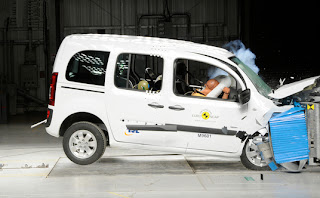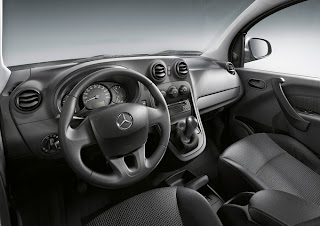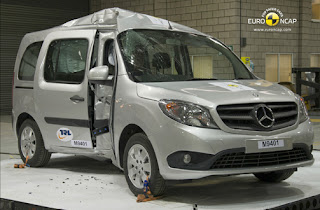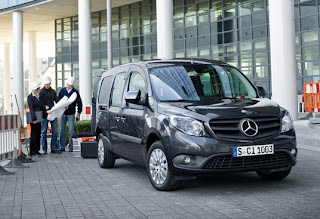 |
| Mercedes Citan Crash Test |
The organization EuroNCAP are assigned three stars in the latest victim of his dreaded crash tests, a Mercedes, at that. But once more, this "shooting" raises more questions than it answers.
The EuroNCAP organization is awarded three stars in the Mercedes Citan, which may be surprising when one considers that his clone, the two Renault Kangoo, had won four in 2008.
Three-star crash-test EuroNCAP is a result which "spot". Especially when there is a builder who wants to feature as Mercedes, in this case. The German brand has just suffered a setback with its MPV Citan, who has been reset severe manner. According to EuroNCAP, the Citan many deficiencies, including side protection flawed as well as a level of active safety deserve only three stars. This last point considered playoff for four stars in the overall rating is causing the degradation of Citan. A process which is, of course, the protocol of the organization, but which poses a number of problems. Which?
 |
Round vents are located on the center console,
while the climate controls and the steering wheel
is different than the Kangoo |
First, you should know that the Citan Mercedes is a clone of the Kangoo 2 Renault. However, tested already in 2008, the Kangoo had obtained four stars. The differences between the two models, however, are cosmetic and do not justify this difference in notation. This disparity can be explained only by the introduction of new criteria, as well as an assessment of more severe outcomes measures. For potential customers of these models, these ratings are troubling, especially as the EuroNCAP evaluation scheme changes almost every year. On its website, the organization clearly indicates that one should not compare the two models rated on two different protocols. But he made no effort to facilitate the reading of the results, recalculating, for example, the old measures based on new rating scales.
 |
According to EuroNCAP, the Citan many deficiencies,
including side protection flawed as well as a level of
active safety deserve only three stars. This last point
considered playoff for four stars in the overall rating is
causing the degradation of Citan |
Second, EuroNCAP has a tendency to move away from its original purpose, namely perform and evaluate crash tests. Its engineers noted more equipment whose effectiveness remains to be seen, not even check their operation. Since 2010, they and award prizes for innovations intended to avoid accidents. However, the mere presence of these systems on board is rewarded with a "decoration", and no test can assess their actual contribution. Worse, as a rule, they have no effect in case of collision, as these assistants conduct supposed to avoid accidents (automatic braking detector drowsiness, monitoring blind ...). The Citan also lacks speed limiter actually costs, so that such a device has no interest in a collision. Mercedes is not alone in this, also because the Dacia Lodgy, which offers the limiter as an option, recently treated to the same punishment. The message EuroNCAP, initially specializing on "shots" standardized (and undeniably competent in this area) is in found blurred.
 |
The look of this MPV evokes the
third generation of Class A |
Third, EuroNCAP undermines its credibility by using questionable methods. This includes essays dynamic behavior, initiated in 2009, and devoid of informational value. As a "test", a single simulation avoidance is performed with a robot that turns the wheel. This does not generate any subjective result (Is that the car is easy to control? Does it reacts gradually and predictably How is she has on wet road?) But EuroNCAP is also the impasse on objective data such as speed cornering or braking distances. Only the "stability" of the car is taken into account and evaluated according to a qu'EuroNCAP calculation does not disclose. The result is not conclusive: so far, all the cars tested were thus passed the test, while the differences between the behavior of cars currently available - we test more than 200 a year - remains important. Moreover, according to our information, the agency has suspended the mock test to start thinking about it. This remains to be confirmed, but the organization has so far not responded to our requests.
In short, the approach to award a single score to assess some sort of level of "general security", mixing impact resistance, safety equipment and dynamic behavior can be considered a failure. To improve the relevance and clarity of its results, EuroNCAP should first focus on its real competence - perform crash tests according to a defined protocol to measure the actual protection of passengers and pedestrians - and stop introducing concepts and considerations that blur the message. Only then, the organization could start also assess the "active safety", which aims to prevent accidents, but according to transparent criteria, and especially scientists. The credibility of EuroNCAP is the price.
Frontal Impact takes place at 64 Km/h, 40% of the width of the car striking a deformable barrier. In the side impact, a mobile deformable barrier impacts the driver's door at 50 km/h. In the pole test, the car tested is propelled sideways at 29km/h into a rigid pole.




No comments:
Post a Comment